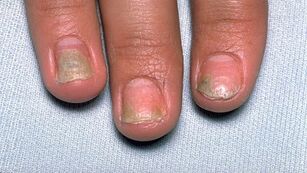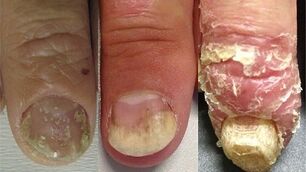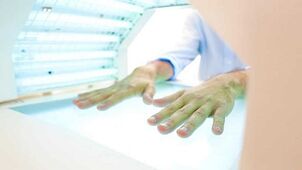One of the variants of skin disease that occurs in a chronic form is psoriasis of the nails. If there is an appropriate spreading factor, it will disturb adults or children. The disease has many similarities with ordinary psoriasis because it is also characterized by pathological stratification of cells that overlap each other, with the result that the nail plate is strongly deformed.
Causes of diseases

Some people believe that psoriasis of toenails or nails can occur under severe stress. Although it has been scientifically proven, strong emotional experience cannot cause this change. Therefore, they cannot be considered as the main cause of disease development. The doctor identified 2 factors that can actually lead to the pathological process:
- The destruction of the immune systemis responsible for the formation of healthy cells and the fermentation of substances. Such changes do not allow skin particles to fully develop. They start to grow and overlap. The result is that the nail plate thickens.
- Susceptibility to the development of psoriasis.In most patients, this gene has an inherent tendency to develop pathology. After the body is negatively affected by certain factors, it will wake up immediately.
Several factors can lead to the activation of the disease:
- Hormonal failure;
- Metabolism problems;
- Long-term use of anti-inflammatory drugs and beta blockers;
- Climate conditions (cold and dry weather);
- Chronic fatigue;
- Infectious disease;
- Damage to the upper layer of the skin.
In half of the cases, nail psoriasis on the hands or feet will develop along with skin lesions.
Psoriasis can only affect nails or other parts of the body.
The first signs of psoriasis on hands, feet and nails
Psoriasis nail lesions can be identified by the characteristics of this symptom. They trouble a person from the first day of disease development. Common signs of pathological processes include:
- Grooves and grooves on the surface of the nail plate;
- Change the color of the nails to a darker color;
- The inflammatory process along the edge of the nail;
- Itchy skin on fingers.
If treatment is not started at the initial stage of disease development, it will continue to develop and its clinical manifestations will be more obvious.
Stage of the disease

The appearance of nail psoriasis, you can determine whether you have carefully studied the diseased plate and the photos of your fingers. In the initial stages of development, pathological manifestations are less obvious. With the successful spread of psoriasis, an increase in symptoms was observed and healthy tissues were affected.
Doctors distinguish the three main stages of nail psoriasis:
- Progressive.At this stage, the nails begin to be covered with small dots, which are painted in a white or yellowish hue. Over time, the size of the pimples increases. At this stage, psoriasis does not affect the deep layers of the nails, so it can be cured quickly. There is no pain when pressed on the affected area, but the surface gradually falls off.
- Fixed.No spots appear on the nails. With that, the inflammatory process will slow down. However, discomfort or pain persists. Sometimes at this stage, the skin next to the board is covered by a rash characteristic of the disease. She herself became very dry;
- is back.The previously formed rash is gradually disappearing. A whitish edge appears near the lesion. Usually, at this stage of the development of psoriasis, patients suffer from intolerable itching.
Observing the development of the disease, the doctor should already know what stage it is in. This will help them find the best treatment for their patients.
If left untreated, psoriasis will invade new areas.
Diagnostic methods
An experienced expert will diagnose and treat skin diseases and can immediately determine whether a person has nail psoriasis. Laboratory research can verify the correctness of the conclusions drawn. To diagnose, you may need:
- Complete blood count;
- Analysis of biopsy or psoriasis scale.
No need for instrument diagnosis for psoriasis.
How to treat nail psoriasis

Nail psoriasis in children and adults requires complex treatments. The tools or procedures for this diagnosis are not enough. For all patients, the treatment of psoriasis of the hands or toes is the standard method. On an individual basis, they are selected for medication and physical therapy. In addition, patients will be advised to adjust their daily diet and make major adjustments to their usual lifestyle. After all, the success of the treatment process also depends on this.
Once a person finds signs of nail psoriasis, they should consult a dermatologist immediately. The above discussed what kind of symptoms will help identify the disease.
Most doctors prescribe topical ointments and systemic tablets
Medications
Diseases similar to nail psoriasis can be treated at home. The doctor will prescribe some medicines that must be taken orally or applied to the affected area.
In the early stages of skin pathology, topical medication should be used. Ointments and creams can be hormonal or non-hormonal. The former requires advanced forms of this disease.
Non-hormonal drugs rarely cause side effects and complications. In addition, they do not lead to addiction compared to more aggressive preparations for external treatment of nail plates.
If the patient’s nails are severely damaged, the doctor will recommend oral medications. He will also tell you how to treat nail psoriasis in this way and the dosage to follow.
Nail psoriasis may require the following medications:
- Immunomodulators (vitamins);
- Antihistamines;
- Sedatives.
In most cases, medications are not stopped until the disease subsides.
Physical Therapy

Nail psoriasis is usually treated with physical therapy. The good results of such violations are as follows:
- PUVA treatment;
- X-ray treatment;
- Ultraviolet radiation;
- Ultrasound therapy;
- Laser therapy.
In order for the results to show only positive after surgery, the number and duration of physical therapy sessions must be correctly selected. This task should be entrusted to experienced professionals. Otherwise, patients trying to understand how to cure psoriasis will experience serious side effects of procedural treatment.
PUVA treatment is one of the most modern and effective methods.
Correct nail care
To make the treatment as effective as possible, patients with psoriasis should pay attention to proper nail care. The disease severely damaged their dishes, so this care will not be redundant. First, it includes compliance with hygiene rules. The doctor recommends the following operations for the diagnosis:
- The nails should be cut as short as possible.
- It is recommended to wear protective gloves when doing housework.
- Avoid work that may damage the nails and the skin around the nails;
- You need to monitor the cleanliness of the nail plate regularly.
If patients follow these rules in addition to folk and traditional treatment methods, medical methods will be more effective.
In psoriasis, protecting your hands from overexposure is especially important.
Folk remedies
Experts in traditional medicine know which plant can cure psoriasis that affects the nail plate. Like many other herbs, they recommend using it when preparing home remedies for skin diseases.
Patients can use the following folk remedies:
- Celandine soup.To prepare it, you need to pour 2 tablespoons of 0. 5 liters of water. l. Herbal medicine. The mixture should be boiled over low heat. On average, it should cook for about 30 minutes. After that, make a medicated bath with the soup, and put your arms and legs down for 20-25 minutes;
- Natural oil.These foods can effectively treat psoriasis. Sea buckthorn oil is particularly beneficial. It can moisturize the skin around the nails and is rich in beneficial trace elements. To treat the affected area with oil, you just need to apply it on a cotton pad and then walk it around on the plate. It is recommended to repeat this step up to 3 times a day.
- Onion compression.It is made from medium onions, which have previously passed through a meat grinder. Place the resulting porridge on the nails and cover with a clean gauze bandage. The application should be kept for 30 minutes;
- Bay leaf soup.It can also be used in the preparation of medicated baths. To cook the soup, you need to pour 2 cups of hot water and 20 grams of grass. Cook the mixture for no more than 10 minutes. Then cool the product to a comfortable temperature, and then put your hands or feet down. You can also take this soup three times a day, 40 grams each time.
- Herbal soup.For the baths, you can prepare prescriptions of celandine, chamomile, oak bark, sage and string. They are made in the same way as the previous recipe.
- Herbal infusion.For oral administration. Self-pharmaceutical is made based on bilberry leaf, St. John's wort, calf root, celandine and string. The ingredients are taken in equal proportions. The amount of infusion is 1 tablespoon. l. Collect and a glass of boiling water. It is recommended to take 50 grams of the drug twice a day.
Folk remedies should be combined with traditional remedies. Otherwise, they will be invalid.
Therapeutic diet

When a person's upper layer of skin is infected, malnutrition may be the cause. Therefore, the human body lacks useful trace elements that support the immune system and other systems. As you know, due to failure, psoriasis occurs. Nails affected by psoriasis can be treated with a special diet. It must be hypoallergenic.
Nutrition for patients with nail psoriasis should be balanced. It is strongly recommended that you exclude foods that may cause allergies. These are chocolate, strawberries, citrus fruits and coffee. You must also give up salty, smoked, pickled, spicy and fatty foods. Ketchup, mayonnaise and mustard are banned.
During the exacerbation of autoimmune diseases, it is recommended to follow a single diet designed for 1-2 days. This nutrition involves only one product. It can be apples, kefir, fish or grains.
The therapeutic diet should be rich in fermented dairy products, fruits, vegetables, herbs and lean fish.
Foods that may cause allergies can also exacerbate psoriasis.
Prevention
It is much easier to try to prevent the development of nail psoriasis. Disease prevention includes the following suggestions:
- You need to include plant foods in your diet;
- Deep-fried, smoked, pickled and salty foods must be abandoned;
- It is recommended to take regular breaks under climatic conditions that are beneficial to the skin and the body as a whole;
- Take a vitamin and mineral complex in the course;
- Avoid damaging the skin and nail plate;
- Treat infectious diseases promptly.
Don't forget to take care of your skin and nails. This is the only way to protect yourself from the development and recurrence of psoriasis.
Forecast
Psoriasis is one of the diseases that has been developing. Medication and physical therapy can only temporarily stop the developmental process. No one can fully recover. If the patient follows the expert’s advice, he will be able to prevent repeated damage to the skin and nails.
Complications and consequences
Psoriatic nail lesions should be treated from the first day of their development. If treatment is missing or incorrectly selected, patients may face the complications and consequences of autoimmune diseases.
People with psoriasis can seriously affect the cardiovascular system. The greatest threat is the blood vessels, because they undergo pathological changes under the influence of diseases.
Any form of psoriasis can cause psychological problems. They are directly related to the fact that others are usually rarely related to people with similar defects in different parts of the body. Therefore, the patient withdrew into his body and began to abuse alcohol. He has been in a state of depression. In the context of psychological distress, the possibility of malignant processes in skin cells increases.























